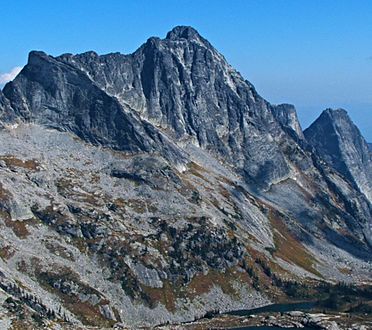Gladsheim Peak facts for kids
Quick facts for kids Gladsheim Peak |
|
|---|---|

Gladsheim Peak, north side with small glacier
|
|
| Highest point | |
| Elevation | 2,830 m (9,280 ft) |
| Prominence | 2,056 m (6,745 ft) |
| Parent peak | Mount Cooper (3094 m) |
| Listing |
|
| Geography | |
| Location | Valhalla Provincial Park British Columbia, Canada |
| Parent range | Valhalla Ranges Selkirk Mountains |
| Topo map | NTS 82F13 |
| Type of rock | Granitic |
| Climbing | |
| First ascent | 1963 by Kim Dean, Parker Williams, Bud Stoval, Jack Oswald, Mike Stewart |
| Easiest route | West Ridge class 5.3 |
Gladsheim Peak is a very tall mountain in British Columbia, Canada. It stands about 2,830 meters (9,285 feet) high. This makes it a prominent summit in the Valhalla Ranges, which are part of the larger Selkirk Mountains.
Gladsheim Peak is the highest point in the Valhalla Ranges. You can find it in the southern part of Valhalla Provincial Park. It is located near Gimli Peak and the town of Slocan.
What's in a Name?
The name "Valhalla Mountains" first appeared on a map in 1890. This map was created by George Mercer Dawson for the Geological Survey of Canada. Dawson chose names from old Norse mythology for many mountains and ranges in this area.
Gladsheim is a special place in Norse mythology. It is a grand meeting hall where the god Odin would gather with other gods. Because of this theme, the name "Gladsheim Peak" was suggested in 1900. It became official on March 31, 1924.
Mountain Climate and Water
Gladsheim Peak has a subarctic climate. This means it has very cold, snowy winters. Temperatures can drop below -20 °C (-4 °F). With the wind, it can feel even colder, sometimes below -30 °C (-22 °F). Summers are usually mild.
Water from the melting snow and rain on the mountain flows into two creeks. These are Gwillim Creek and Mulvey Creek. Both of these creeks eventually flow into the Slocan River. The closest higher mountain to Gladsheim Peak is Mount Cooper.
Reaching the Summit
Many people enjoy climbing Gladsheim Peak. The first group to successfully climb it was in 1963. This team included Kim Dean, Parker Williams, Bud Stoval, Jack Oswald, and Mike Stewart.
There are several established paths, or "routes," that climbers use to reach the top. One of the easier ways is called the West Ridge. Other routes are more challenging and require advanced climbing skills.
Images for kids





